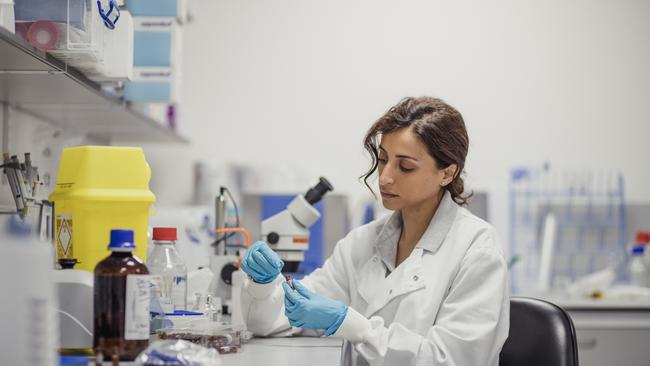’It’s so exciting’: Monash University’s multiple sclerosis treatment breakthrough
It’s a condition that can leave sufferers in a wheelchair unable to control basic bodily functions. But a breakthrough by Monash University scientists could reverse multiple sclerosis.
Health
Don't miss out on the headlines from Health. Followed categories will be added to My News.
Exclusive: Australian researchers have discovered a potential cure for the devastating disease multiple sclerosis by repurposing an old drug used for another rare genetic illness.
Monash University researchers have found the drug DITPA — approved by the US FDA for use in clinical trials to treat a rare disorder called Allan-Herndon-Dudley syndrome (AHDS) — can remyelinate cells in the central nervous system.
Demyelination, or stripping nerve cells of their protective sheath, is a hallmark of MS which causes loss of motor control, muscular spasms, incontinence, weakness, memory loss and problems with thought and planning.
When the drug was used on a mouse model of multiple sclerosis (MS) it tricked the mouse cells into remyelination and paralysed mice were able to walk again.
The research team now needs $2 million to be able to get the drug ready for human clinical trials.

MS affects approximately 2.5 million people worldwide and over 25,000 in Australia. Currently, the best therapies can only limit relapses in patients with the early stage of the disease and there is no cure.
The researcher behind the breakthrough – Dr Steve Petratos – has spent 25 years on MS research and became interested because his grandfather died with the disease.
“There is a significant genetic linkage with MS. I suppose I’m a scientist first and foremost, but you are human and there is an emotional aspect to it,” he said.
In MS, oligodendrocyte cells are mistakenly targeted by the immune system, they play an important role in protecting nerve fibres so stopping this damage is central to treating the condition.
When they tested DITPA in a culture of human cells in a dish, Dr Petratos’ team found it stopped oligodendrocyte cells from dying.
Even better it prompted stem cells to mature into new healthy oligodendrocyte cells.
“It was the regenerative therapy which MS patients have been crying out for,” he said.
“By giving mice the drug we can make them walk again,” he said.
Dr Petratos has since modified DITPA so that it can be effective at just one third of the dose used in the US Defence Department experiments on people with heart failure.
The molecule has the advantage of being able to cross the blood-brain barrier to target affected cells in the brain.
Many treatments that work in mice fail when tried in humans so more testing is needed before it can enter a clinical trial.
“This is a potential game-changer for MS patients in the future as there is only one successful trial to date which has reported effective outcomes of limiting MS progression,” Dr Petratos said.
He is also working on another stem cell therapy for MS that works in a similar way to CAR T-cell therapy for cancer.
He takes stem cells from a patient’s bone marrow genetically modifies them to produce a different protein on the surface, this protein acts like a vacuum that cleans up damaged myelin laying the groundwork for new myelin to emerge.


